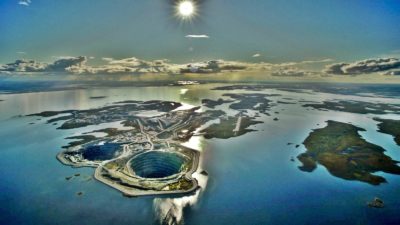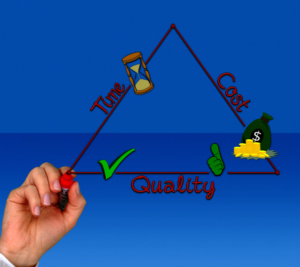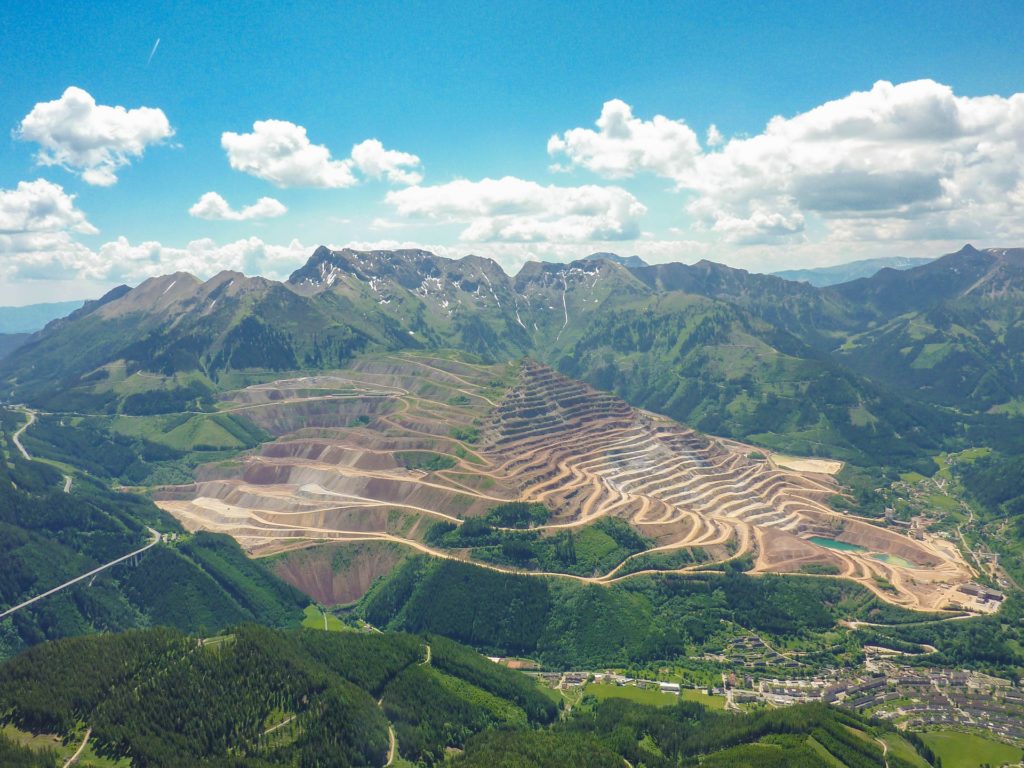In a previous article I outlined my thoughts on the usefulness of early stage financial modelling (“Early Stage “What-if” Mine Economic Analysis – Its Valuable”). My observation was that it is useful to take a few days to build a simple cashflow model to help your team better understand your project.
By “simple” I mean really simple.
This blog describes one of the techniques that I use to take a super-quick look at any project; whether it is for a client wishing to understand his project at a high level; or whether it is a project that I have read about. There isn’t any actual study or production schedule available yet. Maybe there is only a mineral resource estimate available.
It takes about 10 minutes to plug the numbers into my template to get fast results. The image below is an example of the simple model that I use, but anyone can build one for themselves.

Screenshot of Simple Economic Model
I use the term one dimensional (“1D”) model since it doesn’t use the typical X-Y matrix with years across the top and production data down the page.
The 1D model simply relies simple on life of mine (“LOM”) totals to estimate the total revenue, total operating cost, and total profit. This determines how much capital expenditure the project can tolerate.
The only caveat is that you need to have some sense for operating and capital costs for similar projects. This analysis can be on both a pre-tax and simple after-tax basis.
Using estimated metal prices and recoveries, the first step is to calculate the incremental revenue generated by each tonne of ore (see a previous article “Ore Value Calculator – What’s My Ore Worth?”).
Next that revenue per tonne is multiplied by the total ore tonnage to arrive at the total revenue over the life of mine.
The second step is to determine the life of mine operating cost, and again this simple calculation is based on estimated unit operating costs multiplied by the total tonnages being handled.
The third step is to calculate the life of mine profit based on total revenue minus total operating cost.
The potential net cashflow would be calculated by deducting an assumed capital cost from the life-of-mine profit. The average annual cashflow is estimated based on the net cashflow divided by the mine life. An approximate NPV can be calculated by determining the Present Value of a series of annual payments at a certain discount rate.
The reasonableness of the 1D model will be examined via benchmarking and this will be summarized once completed. I will include a link to that future blog here.
You need to understand your project
 One can easily evaluate the potential impact of changing metal prices, changing recoveries, ore tonnages, operating costs, etc. to see what the economic or operational drivers are for this project. This can help you understand what you might need in order to make the project viable.
One can easily evaluate the potential impact of changing metal prices, changing recoveries, ore tonnages, operating costs, etc. to see what the economic or operational drivers are for this project. This can help you understand what you might need in order to make the project viable.
Conclusion
The bottom line is that a 1D economic calculation is very simplistic but still provides a vision for the project. The next step in the economic modelling process would be a 2D model based on an annual production schedule. The 1D approach is just a quick first step in looking at the potential. You can do it even when you only know the head grades and some generalized orebody information.
The two ways you can apply the simple 1-D model are:
-
evaluate the potential of early stage projects using cost inputs from other studies,
-
examine a project’s sensitives (units costs, recoveries, prices) by calibrating your simple model to the published study (i.e. use the same parameters and make changes as needed.
The entire blog post library can be found at this LINK with topics ranging from geotechnical, financial modelling, and junior mining investing.
Note: If you would like to get notified when new blogs are posted, then sign up on the KJK mailing list on the website.

 The tech start-up model is similar to the junior mining business model as it relates to early stage funding followed by additional financing rounds. One obvious difference is that mining mainly uses the public financing route (IPO’s) while the tech industry relies on private equity venture capital (VC’s).
The tech start-up model is similar to the junior mining business model as it relates to early stage funding followed by additional financing rounds. One obvious difference is that mining mainly uses the public financing route (IPO’s) while the tech industry relies on private equity venture capital (VC’s). My first experience with the tech industry was associated with the many after-hours networking meetings called “meetups”. They are held weeknights from 6 to 9 pm and consist of guest speakers, expert panels, and for general networking purposes. Often guest speakers will describe their learnings in starting new companies and failures they had along the way.
My first experience with the tech industry was associated with the many after-hours networking meetings called “meetups”. They are held weeknights from 6 to 9 pm and consist of guest speakers, expert panels, and for general networking purposes. Often guest speakers will describe their learnings in starting new companies and failures they had along the way. Most of the tech meetups are held in local tech offices. These offices are great. They have an open concept, pool tables, ping pong, video games, fully stocked kitchen. Who wouldn’t want to work there?
Most of the tech meetups are held in local tech offices. These offices are great. They have an open concept, pool tables, ping pong, video games, fully stocked kitchen. Who wouldn’t want to work there? In the late 1990’s I was working in the Diavik engineering office in Calgary. They provided a unique office layout whereby everyone had an “office” but no front wall on the office so you couldn’t shut yourself in. There were numerous map layout tables scattered throughout the office to purposely foster discussion among the team.
In the late 1990’s I was working in the Diavik engineering office in Calgary. They provided a unique office layout whereby everyone had an “office” but no front wall on the office so you couldn’t shut yourself in. There were numerous map layout tables scattered throughout the office to purposely foster discussion among the team.


 Irrespective of 43-101, if you are working at a mining operation the last thing you want to do is present management with an incorrect reserve, pit design, or production plan.
Irrespective of 43-101, if you are working at a mining operation the last thing you want to do is present management with an incorrect reserve, pit design, or production plan. As a QP, I suggest the onus is on the software developers to demonstrate that they can produce reliable and comparable results under all conditions. They need to be able to convince the future users that their software is accurate.
As a QP, I suggest the onus is on the software developers to demonstrate that they can produce reliable and comparable results under all conditions. They need to be able to convince the future users that their software is accurate.
 So there likely is a significant network of experienced people out there. It’s just a matter of being able to tap into that network when someone needs specific expertise.
So there likely is a significant network of experienced people out there. It’s just a matter of being able to tap into that network when someone needs specific expertise.

 Changes in economic parameters would impact the original pit optimization used to define the pit upon which everything is based.
Changes in economic parameters would impact the original pit optimization used to define the pit upon which everything is based.
 Once the optimization step is complete, mining engineers will then design the pit inside that shell, introducing benches and ramps. The pit design should mimic the selected optimized shell as closely as possible.
Once the optimization step is complete, mining engineers will then design the pit inside that shell, introducing benches and ramps. The pit design should mimic the selected optimized shell as closely as possible.




 The WBS can provide the following information to the team:
The WBS can provide the following information to the team: Typically a WBS is developed for pre-feasibility and feasibility mining studies but is often ignored at the PEA stage. Some feel it is too detailed for that level of study. I don’t feel this is the case.
Typically a WBS is developed for pre-feasibility and feasibility mining studies but is often ignored at the PEA stage. Some feel it is too detailed for that level of study. I don’t feel this is the case. The bottom line is that regardless of the level of study, a WBS should always be created.
The bottom line is that regardless of the level of study, a WBS should always be created.
 There are numerous factors that will influence the successful completion of a study. They can be related to the quality of the technical team, the budget, the time window, and direction from the Owner. However the key factor that I observed is the competency of the Study Manager (or Project Manager).
There are numerous factors that will influence the successful completion of a study. They can be related to the quality of the technical team, the budget, the time window, and direction from the Owner. However the key factor that I observed is the competency of the Study Manager (or Project Manager). The Study Manager also needs to understand the objectives of the Owner and ensure the team is working towards those objectives.
The Study Manager also needs to understand the objectives of the Owner and ensure the team is working towards those objectives. Often the Environmental Impact Assessment is being conducted concurrently with an engineering study. The level of internal and external communication now becomes even more critical due to the large number of new technical disciplines involved.
Often the Environmental Impact Assessment is being conducted concurrently with an engineering study. The level of internal and external communication now becomes even more critical due to the large number of new technical disciplines involved. The bottom line is that when a project Owner has received proposals for a study and is in the process of awarding that job, the most important consideration is who will be the Study Manager. If possible meet or chat about how they will manage the study and what their experience is. Check references if possible.
The bottom line is that when a project Owner has received proposals for a study and is in the process of awarding that job, the most important consideration is who will be the Study Manager. If possible meet or chat about how they will manage the study and what their experience is. Check references if possible.

 The RFP sent to bidding consultants should contain (at a minimum) the items listed below. A sole sourced study can have a scaled back RFP document, but many of these key items should be maintained.
The RFP sent to bidding consultants should contain (at a minimum) the items listed below. A sole sourced study can have a scaled back RFP document, but many of these key items should be maintained. If a company is competitively bidding the study, it can be easier to compare multiple proposals if certain parts are presented in the exact same format. Usually different consulting firms have their own proposal format, which is fine, however certain sections of the proposal should be made easily comparable.
If a company is competitively bidding the study, it can be easier to compare multiple proposals if certain parts are presented in the exact same format. Usually different consulting firms have their own proposal format, which is fine, however certain sections of the proposal should be made easily comparable.